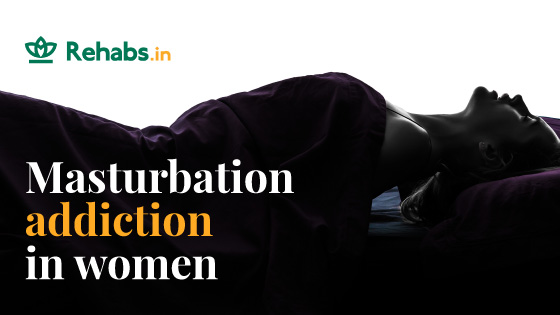Sex and Masturbation Addiction in Females

Compulsive sexual behaviour and masturbation addiction in women
Mr Dixit* was always proud of his daughter. Unlike other teenagers who spent their time in malls and theatres, Riya* always spent time in her room studying. So, imagine Mr Dixit’s shock when Riya’s college principal informed him that she may not be able to move up to the next year due to poor grades. As punishment, he told Riya to keep her door open at all times, so everyone at home could watch her study. In a few days, it was clear to Mr Dixit that something was definitely wrong. Riya was always fidgety and for some reason, she would keep going to the bathroom all the time. Uncomfortable about the whole thing, he asked his wife to take their daughter to a gynaecologist thinking that she may have a Urinary Tract Infection which may be causing her to be in pain making her unable to study. At the clinic, when the gynaecologist found nothing wrong with her, Riya finally admitted that she was addicted to masturbation and didn’t know how to stop. Fortunately, the Dixit’s were a progressive family and sought therapy for their daughter without making her feel judged or punished.
In India or for that matter across the world, women are rarely seen as people with sexual desires. Even in media, women are portrayed as being shy about their sexual needs and anyone who is open about their sexuality is considered “a loose woman”. In such an environment, it becomes difficult to believe that women can have Compulsive Sexual Behaviour Disorders (CSBD) which makes it even harder for women who have CSBD to come forward and seek treatment.
What is CSBD and how is it different from a high sex drive?
CSBD denotes a pattern of habitual sexual behaviours and the incapability to control them. Even though CSBD is not in the Diagnostic and Statistical Manual of Mental Disorders, 5th edition (DSM-5), the World Health Organization (WHO) incorporated compulsive sexual behaviour in the International Classification of Diseases (ICD-11). The ICD-11 defines CSBD as an impulse control disorder. Individuals who are addicted to sex or masturbation display the same behavioural patterns that are usually observed in people with other forms of addiction like alcohol, drugs, gaming, gambling, etc.
Sex and masturbation are personal choices, so who decides how much is too much and how is it different from having a really high sex drive? One could probably explain that people with a high sex drive are stirred by sex itself, they are focussed on the physical part of the arousal. However, they are able to control these urges within the social and personal boundaries of their environments wherein they can have monogamous relationships, won’t indulge in inappropriate behaviour in public, can go by their work without being preoccupied about sex.
People with CSBD on the other hand are unable to control their sexual urges and will seek sex or masturbate even when it may compromise their jobs or relationships. For CSBD or sex addiction sufferers, it is not about sex- it’s actually about addiction. The main goal of a sex or masturbation addict is to get high and not necessarily stimulate their genitals even though both can happen simultaneously. The arousal experience is primarily in the brain. People with CSBD may be unable to hold down jobs, have relationships or have a fulfilling social life.
Is CSBD different in women compared to men?
The short answer is no. The long answer is “we don’t really know”. Most research throughout the years has been more focused on men with the assumption that sex addiction is a male domain. When it comes to studying women’s sexuality it has often been around the topics of “low libido” and “painful intercourse”.
Men and women with CSBD may share similar traits like impulse control around people, cheating on partners, engaging in risqué behaviour in social settings, etc. However, what may differ between them is how they view their addiction.
Dr Patrick Carnes, the author of Don’t Call It Love, informs that men with CSBD prefer to engage in sexual behaviours that are devoid of emotions, hence, there is a preference for prostitutes, strangers and random hook-ups. This doesn’t mean they won’t seek sexual favours from friends or acquaintances, they would just prefer to take the emotions out of the equation. Women, on the other hand, may use sex as a form of power to control or to get attention. In fact, some may even use sex as a way of acting out against the male-dominated society that has repressed women for a long time. However, no matter how men and women view their addiction behaviour the signs of CSBD are quite similar among both sexes.
Signs of CSBD and treatment methods
Sex and masturbation are very subjective topics. Being addicted to drugs can kill you and hence one needs to pay close attention to all the warning signs. Being addicted to masturbation and sex, on the other hand, is a personal affliction and one needs to look for signs that may cause mental and social harm and in rare cases physical problems. Some of the signs that a woman is suffering from CSBD are:
· A history of inappropriate sexual relationships with bosses, subordinates, spouses of friends, neighbours and in some cases family members.
· Engaging in high-risk sexual activity like public sex, masturbating in public places, unprotected sex, etc.
· Using one’s risqué behaviour as a power move to control, manipulate and get away with bad behaviour
· Multiple affairs while in a relationship with a partner
· Trading sex for everything, from paying the rent to buying groceries
· Unable to maintain stable relationships with friends, family members and acquaintances
· Spending a lot of time in isolation often watching porn or masturbating
CSBD is currently defined in the eleventh edition of the International Classification of Diseases (ICD-11) as an impulse control disorder and is characterized by a persistent pattern of failure to control intense, repetitive sexual urges and behaviours”. It is important to note that one cannot diagnose someone as having CSBD based on personal or moral judgements about what is the right amount of sex and the number of partners or disapproval on types of sexual behaviour and preferences.
Treatment from an addiction expert or sex therapist may help. Sex Addicts Anonymous (SAA) use the 12-step program of recovery, women in SAA have a safe space to discuss their addiction and have help from mentors who have been former sex addicts themselves. Besides counselling, cognitive behavioural therapy, cognitive analytic therapy and mindfulness practices have proved to be beneficial.
In addition to therapy, there are also medicinal treatments for sex addiction. Some of the medicines that help in reducing compulsive sexual behaviours include Fluoxetine (Prozac or Sarafem), Sertraline (Zoloft), Citalopram (Celexa) and Naltrexone (Vivitrol or Revia). These medications are prescribed by qualified doctors and should not be taken without prescriptions.
Women with CSBD can be more vulnerable
To make it clear, men and women are equally vulnerable when it comes to CSBD and masturbation addiction, however, women tend to suffer a little more.
Men who sleep around are termed as ‘manly’ and not as badly judged, hence seeking treatment is a little easier than it is for women with CSBD. Women are still judged for having sexual desires, so one can imagine the kind of mistreatment women with CSBD would face. This makes it extremely difficult for women with CSBD to confide about their problems with their family or friends and seek the treatment they need. Besides troubles with seeking treatment, women with CSBD have a risk of getting STDs or having an unwanted pregnancy. Multiple abortions may also lead to problems with fertility in later life. Random hook-ups with strangers can also lead to dangerous situations like robbery, rape, kidnapping, etc. Women also face the danger of being blackmailed by people, who may seek sexual favours or money in exchange for keeping their sex addiction a secret.
In closing, women are equally prone to suffer from CSBD like men. As a society, we need to create a safe space for them so that they can come out and seek the treatment they need. Women with CSBD can be capable employees, mothers, caregivers, friends and reach their potential. All we have to do is acknowledge them and help them.
Sources:
Borreli, L. (2015, March) Hypersexual Disorder or Just a High Sex Drive? The Profile of a Sex Addict. https://www.medicaldaily.com/
Kürbitz, L., Peer Briken, P. (2021, July) Is Compulsive Sexual Behavior Different in Women Compared to Men? https://www.ncbi.nlm.nih.gov/pmc/articles/PMC8348482/#:~:text=The%20lifetime%20prevalence%20of%20CSBD,current%205.4%25%2F1.4%25
O’Hara, S., (2012, June) How are Female Sex Addicts Different from Males? https://psychcentral.com/blog/how-are-female-sex-addicts-different-from-males#1
Understanding Sex Addiction in Women. https://sexandrelationshiphealing.com/for-addicts/understanding-sex-addiction-women/
Compulsive sexual behavior. https://www.mayoclinic.org/diseases-conditions/compulsive-sexual-behavior/diagnosis-treatment/drc-20360453
(2022, Jan) When Should You Seek Help as a Female Addicted to Sex? https://www.betterhelp.com/advice/intimacy/when-should-you-seek-help-as-a-female-sex-addict/
Weiss, R., (2011, Sept) Can Women Be Sex Addicts? https://www.livescience.com/16113-women-sex-addicts.html
Ley, D., (2018, Jan) Compulsive Sexual Behavior Disorder in ICD-11- What does this mean, for advocacy against sex addiction diagnosis? https://www.psychologytoday.com/us/blog/women-who-stray/201801/compulsive-sexual-behavior-disorder-in-icd-11
Mateusz Gola, M., Lewczuk, K., Potenza, M., Kingston, D., Grubbs, J., Stark, R., Reid, R. (2020. Nov) What should be included in the criteria for compulsive sexual behavior disorder? https://akjournals.com/view/journals/2006/aop/article-10.1556-2006.2020.00090/article-10.1556-2006.2020.00090.xml
World Health Organization. (2019). ICD-11: International classification of diseases (11th revision). https://icd.who.int/














